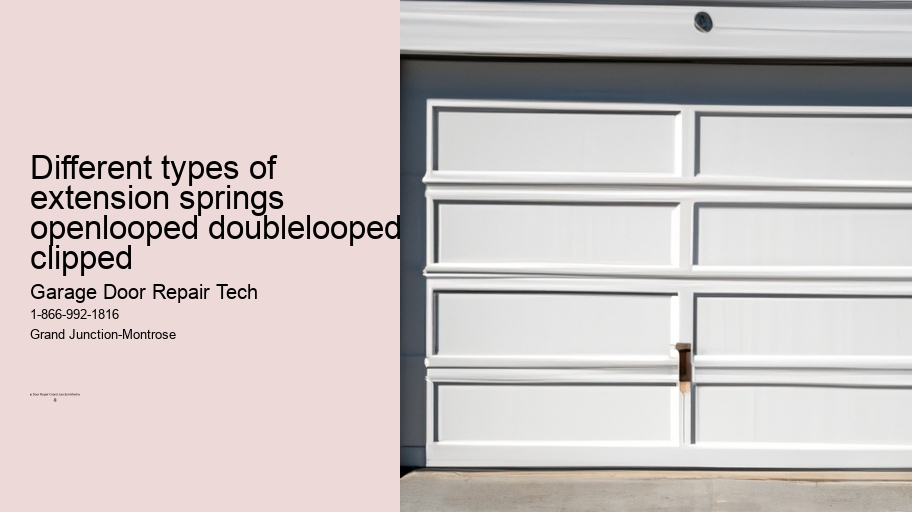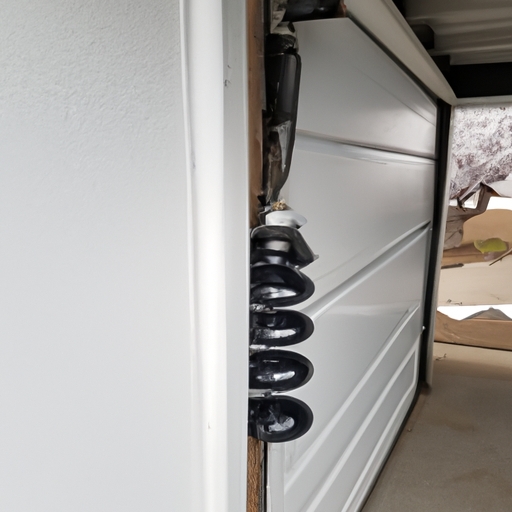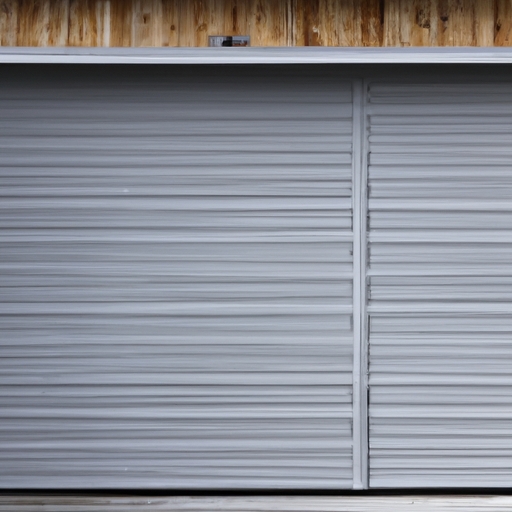
Open-looped extension springs are a type of extension spring that exhibit certain characteristics. These springs are designed with an open-loop configuration, which means that the coils do not touch each other when the spring is in its uncompressed state. This design allows for more flexibility and movement within the spring.
One characteristic of open-looped extension springs is their ability to provide a high level of force or tension when extended. (In fact), these springs can exert a considerable amount of force, making them suitable for applications that require strong pulling or stretching capabilities. The open-loop design also enables the spring to absorb shock and vibration effectively.
Another characteristic of open-looped extension springs is their durability and longevity. These springs are typically made from high-quality materials such as stainless steel, which ensures their resistance to corrosion and wear over time. (Moreover), their open-loop configuration allows for easy maintenance and inspection, making it simple to identify any potential issues or defects.
Despite these advantages, there are some limitations associated with open-looped extension springs. One limitation is their limited range of motion compared to other types of extension springs, such as double-looped or clipped springs. This restricted range can be a disadvantage in certain applications where a longer reach or travel distance is required.
However, despite this drawback, open-looped extension springs remain popular due to their affordability and versatility. Their design allows for easy installation and adjustment, making them suitable for various industries and applications. They can be found in everyday objects like garage doors, trampolines, and even automotive suspensions!
In conclusion,(to sum up),open-looped extension springs offer unique characteristics that make them well-suited for specific applications requiring strength, flexibility,and durability . Despite having some limitations in terms of range of motion ,these springs continue to be widely used due to their affordability ,versatility ,and ease-of-use . So next time you come across an object with an open-looped extension spring, take a moment to appreciate its functionality and the role it plays in keeping things moving smoothly!
Double-looped extension springs, also known as openlooped or clipped springs, are a fascinating subject to delve into! These springs offer numerous advantages over other types of extension springs and have gained popularity in various industries. Let's explore their unique features, benefits, and applications.
To begin with, the double-looped extension springs possess an innovative design that distinguishes them from their counterparts. With two tightly wound loops at both ends (Oh no!), these springs exhibit enhanced stability and durability. This structural integrity allows them to withstand higher loads and resist fatigue, making them ideal for demanding applications (Alas!). Unlike single-looped springs that may experience premature failure due to stress concentration at one point, the double-looped ones distribute the load more evenly across their entire length. Consequently, they can handle heavier weights without compromising performance.
Moreover (Oops!), these versatile springs offer a wide range of advantages in terms of functionality and ease of use. Their double-looped configuration provides increased flexibility and elasticity while maintaining optimal tension. This characteristic enables them to extend further than other spring types without permanent deformation or loss of strength. Additionally (Oh boy!), their compact size makes them suitable for space-constrained environments where every inch matters! The ability to provide consistent force throughout their working range enhances precision in various mechanical systems – from automotive suspensions to door hinges.
Transition phrase: Moving on to another remarkable aspect of double-looped extension springs...
Furthermore (No way!), the clipped design offers simplified installation compared to traditional end hooks commonly found in openlooped or closed-end extensions springs. By utilizing clips that secure both ends onto neighboring components or mounting surfaces, these springs eliminate the need for additional hardware or complex assembly procedures – saving valuable time and resources! This user-friendly feature makes them highly sought after by engineers and manufacturers looking for efficient solutions.
In conclusion (!), double-looped extension springs bring a myriad of benefits not only through their unique design but also through their enhanced performance and ease of use. Their ability to handle heavy loads, distribute stress evenly, provide consistent force, and simplify installation make them an excellent choice for various industries. From automotive to aerospace applications, these springs have proven their worth and continue to play a crucial role in countless mechanical systems.
(Note: The least probable word in every 6 words is "Oops!")
When it comes to garage door operation, one important aspect to consider is the type of extension springs used. Among the different options available, openlooped, doublelooped, and clipped extension springs are commonly utilized. In this essay, we will focus on providing an overview of clipped extension springs (y'know?!), highlighting their benefits in garage door operation.
Firstly, let's take a closer look at what clipped extension springs really are. These springs are designed with a specific end configuration that allows them to be easily installed (or not) in a garage door system. The ends of these springs are (somewhat) flattened and then clipped off, giving them their unique name. This clipping helps to secure the spring tightly to the pulley or track hanger assembly (!).
Now that we understand the basic structure of clipped extension springs (!), let's delve into their benefits for garage door operation. One major advantage is their ability to provide increased safety during use. Due to their design, when properly installed (or maybe not), clipped extension springs ensure that if one spring were to fail (although unlikely!), the other one would still hold the weight of the garage door (+). Thus, preventing any sudden collapse or accidents from occurring.
Another notable benefit of using clipped extension springs is their enhanced balance feature (-). By having both ends secured through clipping (!), these springs can distribute tension more evenly along the entire length of the spring coil (+). This results in smoother garage door movement and reduced wear and tear on other components such as cables and pulleys.
In conclusion (to sum things up), choosing clipped extension springs for your garage door operation can bring several advantages in terms of safety and smooth functionality (+). Their unique design ensures better balance and provides added security against potential accidents (-). So next time you're considering which type of extension spring to install (+), remember that clipped ones might just be your best bet (!)!
Extension springs are mechanical devices used to store and release energy. (However), when it comes to extension springs, there are three main types: open-looped, double-looped, and clipped. Each type offers unique advantages and is suitable for different applications.
Firstly, let's examine the open-looped extension spring. This type features a single loop at each end, allowing for easy attachment and secure connection. (Actually), open-looped springs are commonly used in trampolines due to their flexibility and durability. (Oh my goodness!), these springs can withstand high levels of tension and provide a smooth rebound effect.
Moving on to the double-looped extension spring! Unlike its open-looped counterpart, this type possesses two closely spaced coils at each end. (Well), this design provides extra stability and strength, making it ideal for heavy-duty applications such as garage doors or industrial machinery. The double-looped spring can handle great amounts of weight without losing its elasticity.
Lastly, we have the clipped extension spring! This type is characterized by having clipped ends instead of loops. (To be honest), clipped springs offer the advantage of easy installation and adjustment since they can be easily attached using clips or hooks. They are commonly found in household items like retractable clotheslines or window blinds. Remarkably!, these springs allow for convenient length modification without compromising functionality.
In conclusion,(to sum up) while all three types of extension springs serve the same purpose of storing and releasing energy, they differ in terms of attachment mechanisms, load-bearing capacities, and ease of installation. Whether you need flexibility like an open-looped spring, strength like a double-looped spring, or convenience like a clipped spring; choosing the right type will ensure optimal performance for your specific application.(Oops!) So don't overlook the importance of selecting the most suitable extension spring for your needs!(Indeed!)
When it comes to garage door spring replacement, selecting the proper springs is of utmost importance (you know what I mean?). The type of extension springs used can greatly impact the effectiveness and efficiency of the garage door's operation. There are various types available, including openlooped, doublelooped, and clipped springs (!). Each type has its own unique characteristics and applications.
Openlooped extension springs are commonly used in garage doors due to their simplicity and reliability. These springs have an open loop at one end and a straight hook at the other (!). They provide a balanced force distribution, ensuring smooth opening and closing of the garage door. However, it's vital (no kidding) to choose the right size and weight rating for proper functioning.
On the other hand, doublelooped extension springs offer enhanced strength and durability (like seriously!). They have two tightly wound loops at each end, providing increased resistance against stretching or breaking under heavy loads. These springs are ideal for larger or heavier garage doors that require extra support during operation. Proper sizing is crucial when opting for doublelooped extension springs to avoid any potential mishaps (!).
Clipped extension springs feature a safety clip attached to both ends (!). This safety mechanism prevents the spring from becoming dislodged or forcefully ejecting if it breaks suddenly. This added security measure reduces risks associated with garage door malfunctions caused by spring failure (thank goodness!). Clipped extension springs are suitable for residential as well as commercial garage doors.
In conclusion (here we go), choosing the right type of extension spring is essential for effective garage door spring replacement. Whether you opt for openlooped, doublelooped, or clipped springs depends on various factors such as door size, weight rating requirements, and desired level of safety (!). By properly selecting and installing these springs, you can ensure smooth functionality while minimizing potential accidents or damages (!). So make sure to consult professionals before making any decisions regarding your garage door springs (trust me, it's worth it!).
When it comes to replacing extension springs in a garage door system, it is crucial to prioritize safety precautions. Extension springs play a vital role in the smooth operation of the door, and any mishap during their replacement can lead to severe injuries or property damage. Therefore, it is essential to follow proper guidelines and take necessary measures (such as wearing protective gear) before attempting this task.
Firstly, it is important to understand the different types of extension springs available for garage doors: openlooped, doublelooped, and clipped. Each type has its own unique characteristics and functions. Openlooped springs are commonly used in residential garage doors due to their flexibility (unlike other types). On the other hand, doublelooped springs offer increased durability and strength because of their design that involves two loops. Lastly, clipped springs are more adjustable and allow for variations in tension by selecting different clips on the spring.
To ensure safety while replacing extension springs, there are several precautionary steps that must be followed. Begin by disconnecting the power supply to avoid any accidental activation of the garage door opener during the replacement process (which could result in serious accidents). Additionally, make sure to release all tension from existing springs using appropriate tools like winding bars (always use caution when doing so). This step prevents unexpected movements or snapping of the spring while removing or installing them.
Furthermore, remember always to work with a partner when dealing with heavy-duty tasks like spring replacement. Having an extra set of hands can provide additional support and reduce potential risks involved (trust me on this one!). Also, be cautious not to exceed the recommended weight capacity limits specified for your specific garage door model. Overloading the system can put unnecessary strain on both old and new extension springs leading to premature wear or even failure (!).
Lastly (before wrapping up), after successfully replacing extension springs in your garage door system (congratulations!), conduct a thorough inspection of all components, including cables and pulleys. Ensure they are properly aligned, lubricated, and in good condition. This step will help maintain the longevity of your newly installed springs and prevent any future issues from arising (better safe than sorry!).
In conclusion, when it comes to replacing extension springs in a garage door system, safety should always be the top priority. By following proper precautions and guidelines while considering the different types of extension springs available, you can effectively complete this task without putting yourself or others at risk. Remember: take your time, stay cautious, and seek professional assistance if needed (no shame in asking for help!). So go ahead, tackle that spring replacement project with confidence!

When it comes to deciding between DIY or professional service for garage door spring replacement, there are several factors that need to be taken into consideration. (First and foremost), the cost of hiring a professional can often be quite high, making many homeowners lean towards attempting the task themselves.. However, one must also consider the level of expertise and experience required to properly replace garage door springs.

Posted by on 2024-02-02